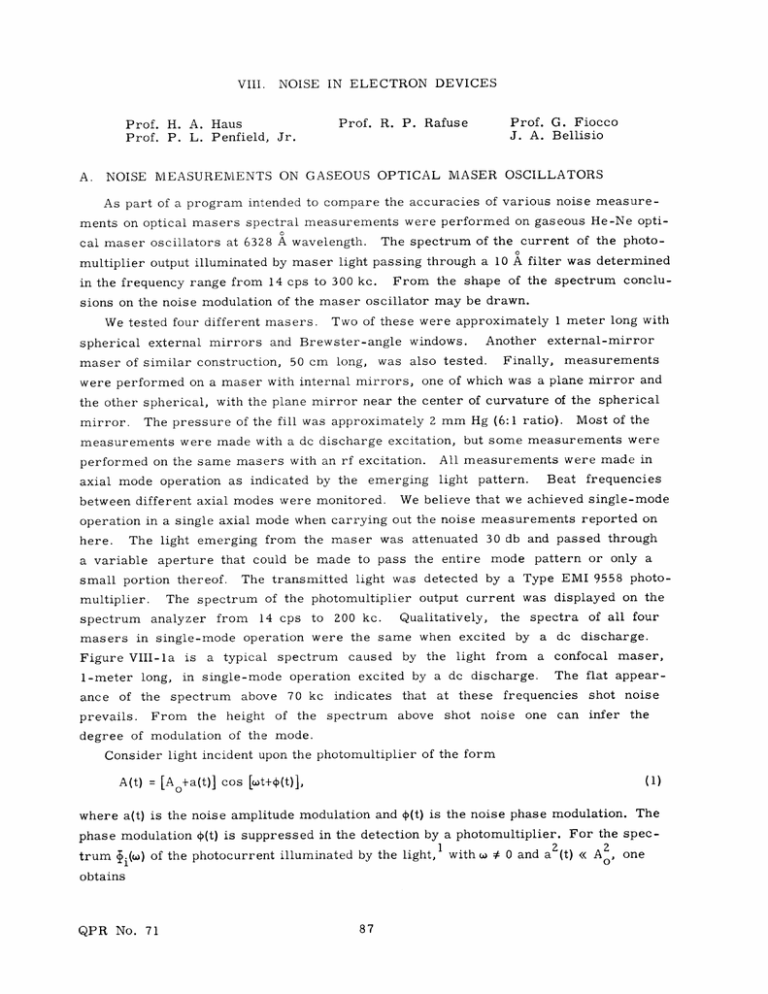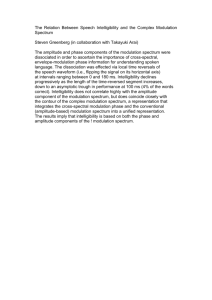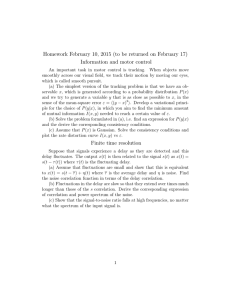Prof. G. Fiocco J. A. Bellisio
advertisement

VIII. NOISE IN ELECTRON DEVICES Prof. H. A. Haus Prof. P. L. Penfield, Jr. A. Prof. R. P. Rafuse Prof. G. Fiocco J. A. Bellisio NOISE MEASUREMENTS ON GASEOUS OPTICAL MASER OSCILLATORS As part of a program intended to compare the accuracies of various noise measurements on optical masers spectral measurements were performed on gaseous He-Ne optical maser oscillators at 6328 A wavelength. The spectrum of the current of the photomultiplier output illuminated by maser light passing through a 10 A filter was determined in the frequency range from 14 cps to 300 kc. From the shape of the spectrum conclusions on the noise modulation of the maser oscillator may be drawn. We tested four different masers. Two of these were approximately 1 meter long with Another external-mirror spherical external mirrors and Brewster-angle windows. maser of similar construction, 50 cm long, was also tested. Finally, measurements were performed on a maser with internal mirrors, one of which was a plane mirror and the other spherical, with the plane mirror near the center of curvature of the spherical mirror. The pressure of the fill was approximately 2 mm Hg (6:1 ratio). Most of the measurements were made with a dc discharge excitation, but some measurements were performed on the same masers with an rf excitation. All measurements were made in Beat frequencies axial mode operation as indicated by the emerging light pattern. between different axial modes were monitored. We believe that we achieved single-mode operation in a single axial mode when carrying out the noise measurements reported on The light emerging from the maser was attenuated 30 db and passed through a variable aperture that could be made to pass the entire mode pattern or only a small portion thereof. The transmitted light was detected by a Type EMI 9558 photoThe spectrum of the photomultiplier output current was displayed on the multiplier. here. Qualitatively, the spectra of all four 14 cps to 200 kc. masers in single-mode operation were the same when excited by a dc discharge. Figure VIII-la is a typical spectrum caused by the light from a confocal maser, spectrum analyzer from in single-mode operation excited by a dc discharge. The flat appearance of the spectrum above 70 kc indicates that at these frequencies shot noise prevails. From the height of the spectrum above shot noise one can infer the degree of modulation of the mode. Consider light incident upon the photomultiplier of the form 1-meter long, A(t) = [Ao+a(t)] cos [ot+p(t)], (1) where a(t) is the noise amplitude modulation and p(t) is the noise phase modulation. The phase modulation p(t) is suppressed in the detection by a photomultiplier. For the spectrum (i(w) of the photocurrent illuminated by the light, obtains QPR No. 71 1 2 2 with w t 0 and a (t) << A , one (VIII. NOISE IN ELECTRON DEVICES) I = 4Im2 4i() a(w) + Gae . Here, I1 is the dc anode current of the photomultiplier, (2) la(w) is the spectrum of the amplitude modulation of the light normalized so that a() dw = 1, G is the photomultiplier gain, and a is the shot-noise enhancement factor caused by secondary emission in the photomultiplier. We experimentally determined a to be 1.2, in close agreement with theoretical predictions.2 The modulation ratio, m2, is defined as m 21lim A T -o00 T/2 a (t) dt . 2 -T/ (3) One may determine m2 from Eq. 2 by measuring the area of the portion of the spectrum above the enhanced shot noise. In order to make certain that the flat portion of the spectrum observed in the photomultiplier output was indeed pure shot noise (enhanced by the secondary emission) three separate calibration measurements were performed. (i) Light from a flashlight was passed through the 10 A filter. With an anode current of the same value as that achieved with the maser it was found that the spectrum produced by the flashlight (which was entirely flat) had the same magnitude as the flat portion of the spectrum produced by the maser. (ii) The maser light was modulated 100 per cent by a chopper wheel. This modulation resulted in the appearance of peaks in the spectrum with the fundamental equal to the frequency of modulation. Knowing that the width of the spectrum-analyzer filter was 27 cps, we could calibrate the shot-noise current from a measurement of the height of the modulation peaks. (iii) The shot noise in the anode current was compared directly with the noise produced by a shot-noise diode. By using the value of gain quoted by the manufacturer, the shot-noise enhancement factor a produced by the secondary emission in the photomultiplier could be determined. In the example in Fig. VIII-1 with a current of Io = 7.5 10 - 5 amp, a value m = 0.12 is obtained from Eq. 2. This measured m value was independent of the aperture size. The short laser, 50 cm long, gave higher values of m. The spectrum shown in Fig. VIII-la may be attributed entirely to fluctuations in the dc gas discharge. We have taken spectral measurements of the noise current in the The spectrum of the anode current, obtained under the same operating conditions as for the photomultiplier spectrum of Fig. VIII-la, is shown in Fig. VIII-lb. The shapes of the two spectra are quite similar. As another proof that the spectrum of Fig. VIII-1 is associated with the characteristics of dc gas discharges anode lead of the discharge. we report measurements performed on the same maser with rf excitation. Figure VIII-2 QPR No. 71 0 I 0 100 Fig. VIII-1. 200KC I 100 (a) Spectrum of maser excited by dc discharge. noise current in anode lead of discharge. o Fig. VIII-2. QPR No. 71 I 0 100 (b) Spectrum of 200KC Spectrum of maser excited by radio frequency. 89 200 KC (VIII. NOISE IN ELECTRON DEVICES) No structure is visible, shows the spectrum of the maser excited by radio frequency. thereby indicating that a modulation of the light output is less than could be detected with the present experimental arrangement. In conclusion, we can state that fluctuations associated with dc gas discharges cause noise modulations of the light of dc discharge masers. per cent. 3 These may be as low as a few The use of rf discharges eliminates such modulations. The measurement of the degree of noise modulation of the maser light from rf discharges awaits perfection of the equipment. With a value 10 = 1 ma the present equipment would be capable of detecting a modulation coefficient of m and a bandwidth of 10 mc. = 1.6 X 10 - 3 with a signal-to-noise ratio of 1 The bandwidth expected in our measurement would be of this order if limited by the hot Q of the oscillator. Such modulation was not observed; thus it is indicated that the noise modulation of a maser oscillator excited by rf discharge must be less than that. We acknowledge many helpful discussions with Professor G. Professor A. Javan, and Dr. R. Carbone. Fiocco, Dr. A. Szoke, This work was carried out jointly with Mr. C. Freed of Lincoln Laboratory, M. I. T. J. A. Bellisio, H. A. Haus References 1. This is a modified form of an equation derived by C. Th. J. Alkemade, On the excess photon noise in single beam measurements with photoemissive and photoconductive cells, Physica 25, 1145-1158 (1959). 2. A. van der Ziel, Noise (Prentice-Hall, Inc., New York, 3. P. T. Bolwijn, C. Th. J. Alkemade, and spectral line shape of laser beam, Phys. similar spectra on measurements on a short We found much smaller modulation values. excitation. QPR No. 71 1954). and G. A. Boschloo, Excess photon noise Letters 4, 59-61 (1963), have observed infrared maser, excited by a dc discharge. These workers did not test rf discharge






